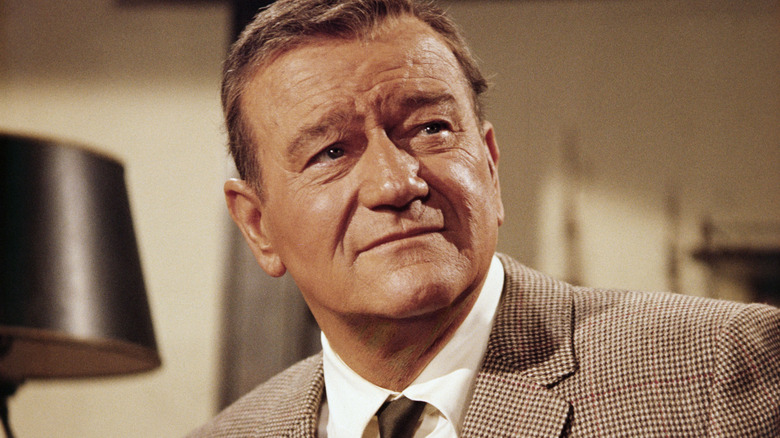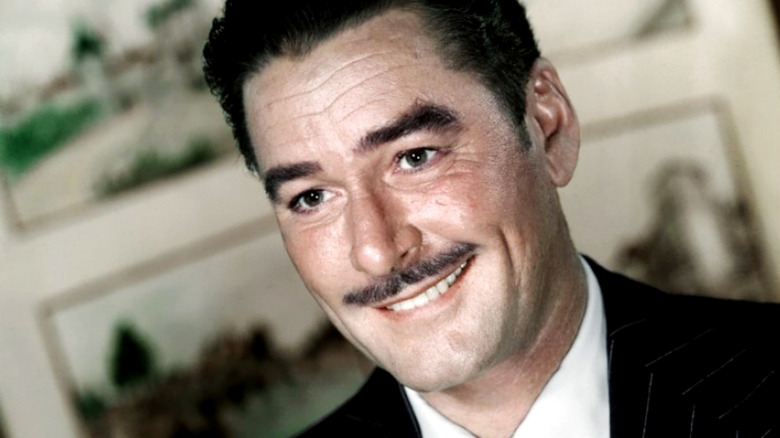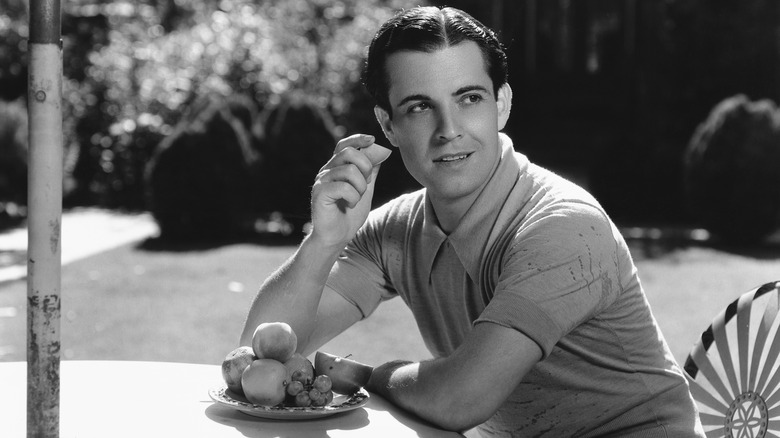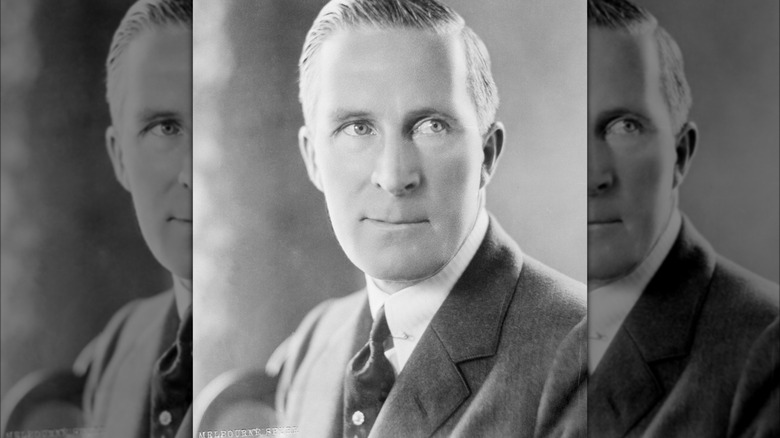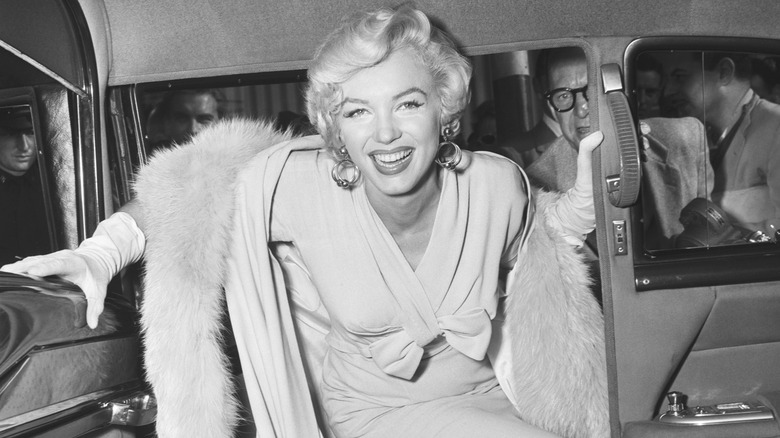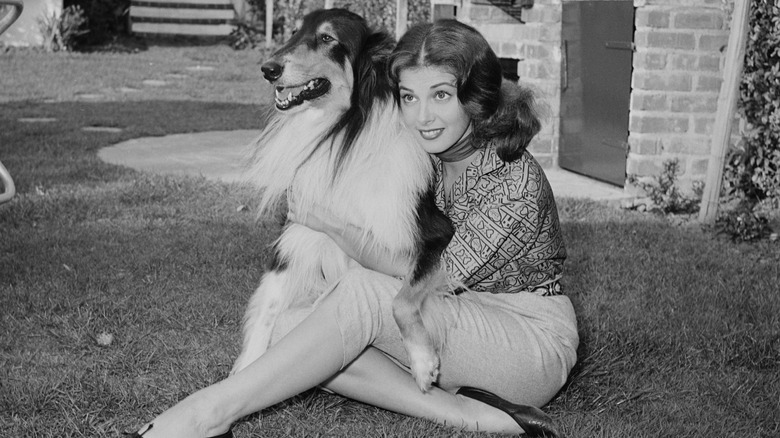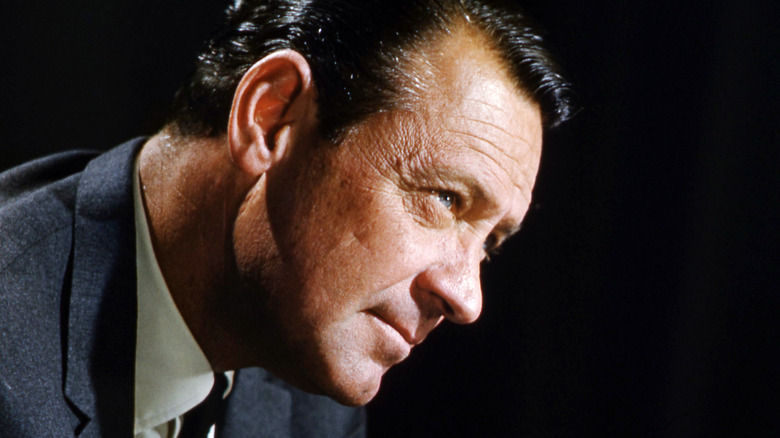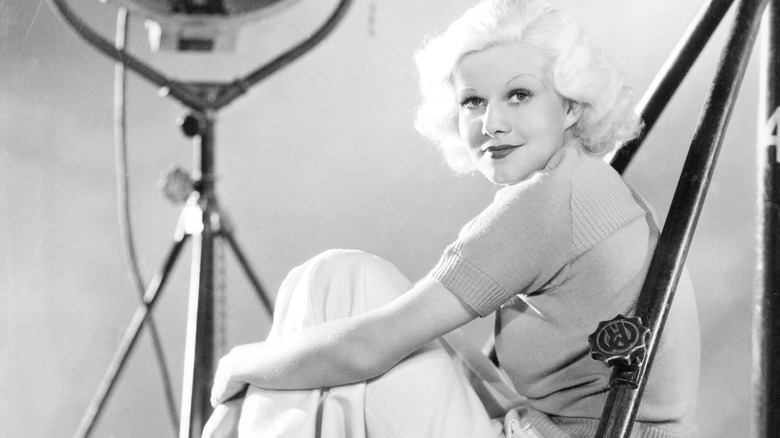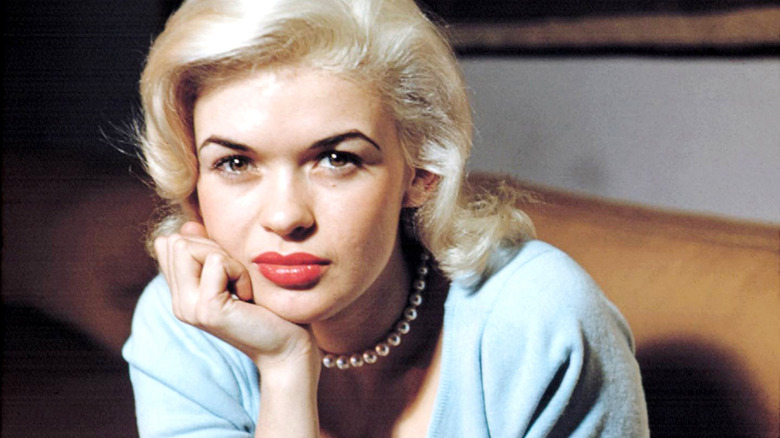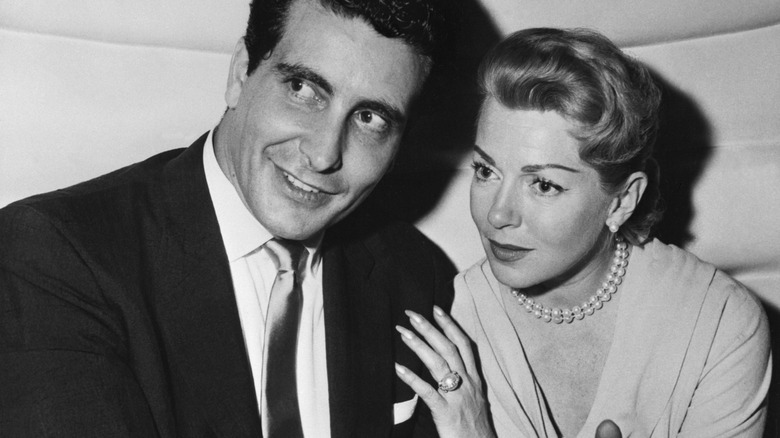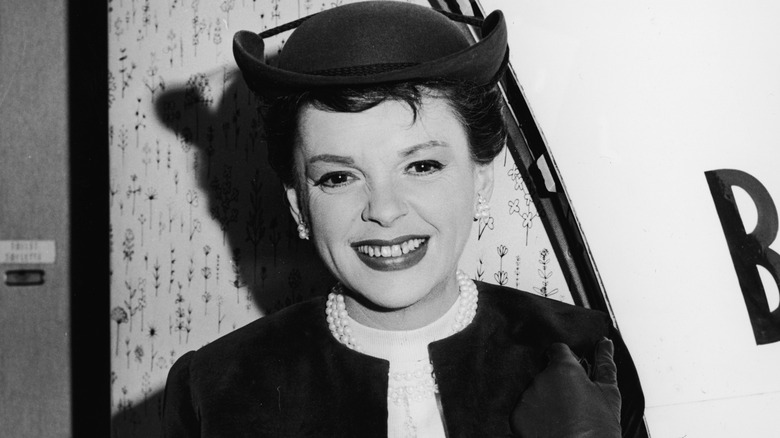Sad Things Found In Old Hollywood Celebrity Autopsy Reports And Death Certificates
Looking back at decades past usually comes with a massive dose of mourning the good old days, but... why is that? And were they really that good? Probably not: And that's according to Warwick Business School behavioral science professor Nick Chater. Chater says that there are likely a few things going on here, including the fact that "our memory tends to forget about the bad events in our past, and we have a tendency to rehearse and dwell on the good things that happened in the past, we retell them a lot more often, so we reinforce the good memories. We tend to remember the great songs or cars or football players from the 'old days,' and forget all the bad ones."
That works in the context of Old Hollywood, too. We remember the good things: The classy people, the dramatic stories, the beautiful costumes, the glitz and glamor. The fact that it was still perfectly acceptable to smack a woman into her place? That's not mentioned as often.
And neither are the incredibly difficult lives that actors and actresses of Old Hollywood led. Child actors were put through grueling schedules and held to adult standards, stunts weren't nearly as safe and carefully done as they are today, and directors weren't above a little emotional and physical abuse, if it meant getting the job done. With that in mind, let's take a look at some of the most heartbreaking details the world learned after these Old Hollywood stars passed away.
John Wayne
John Wayne needs no introduction: He was one of Old Hollywood's great tough guys. Who, after all, could better embody the spirit of the even Older West? Wayne died in 1979, and according to his official death certificate (via Find a Death), the cause was respiratory arrest and gastric cancer. Cancer is always an awful way to go, but in Wayne's case, it's been theorized that his cause of death told an even broader, even sadder story.
As early as 1980, the families of John Wayne, Susan Hayward, and director Dick Powell were drawing a shocking connection between Old Hollywood deaths and the set of 1956's "The Conqueror," that film of questionable taste that cast Wayne as Genghis Khan. Let's talk numbers first: Of the 220 people who worked on location, 91 were diagnosed with cancer by 1980, and 46 had died. Survivors were understandably certain that it had something to do with the 11 bombs — including radioactive bombs, one of which was nearly three times more powerful than the one that had destroyed Hiroshima — that were dropped near the film's location the year before.
In an interview with People, University of Utah's director of radiological health Dr. Robert C. Pendleton noted that on average, current statistics suggested that around 30 people out of a group of 220 would develop cancer. "With 91, I think the tie-in to their exposure on the set of 'The Conqueror' would hold up even in a court of law."
Errol Flynn
Errol Flynn may have been known for his big-screen adventure movies, but some of his most iconic characters couldn't hold a candle to the real deal. Still, Flynn's career took a massive stumble when he was accused of having sexual encounters with two underage girls, and the years leading up to his death were spent largely in seclusion and with the company of alcohol. His autopsy report (via AutopsyFiles) reveals just how far his star had fallen.
Flynn had reportedly sought medical attention for chronic back pain that had steadily worsened, and according to the doctor who treated him, he collapsed not long after receiving an injection for the pain. His then-girlfriend, Barbara Aadland, carried amyl nitrate with her: According to the doctor, that confirmed that he had suffered cardiac issues before.
Cardiac issues were just a small part of the postmortem findings. In addition to myocardial infarction, coronary thrombosis, and coronary atherosclerosis, the exam also found diverticulosis of the colon. The Cleveland Clinic says that's pretty normal and relatively problem- and symptom-free, but more troubling was the fact that his years of heavy alcohol use had led to cirrhosis and fatty degeneration of the liver. At the time of his death, he had a blood alcohol level of 0.25%, which the University of Toledo says is when most people start to approach comatose. The doctor who tended to him noted no ill effects, suggesting that he was accustomed to those levels of alcohol in his system.
Carole Lombard
When the U.S. finally entered World War II, it was all hands on deck. That included a number of Hollywood A-listers, and among the first to sign up to sell war bonds was Carole Lombard. Lombard was one of the driving forces behind the country's war bond sales effort and also became one of the war's most high-profile stateside casualties: On January 16, 1942, Lombard was returning to Los Angeles from a war bond drive event when her plane crashed on Mt. Potosi.
Lombard died in the crash, and was later buried alongside her mother. (Her then-husband, Clark Gable, was so grief-stricken that he temporarily turned his back on Hollywood, enlisted, and joined in active combat missions. After his death in 1960, he was buried beside her.)
Search parties who scoured the 22-mile-long crash site retrieved Lombard's body fairly quickly, and according to her death certificate (via Oak Auctions), her last moments were unthinkably horrible. The official cause of death was "fracture of skull, shock, [and] fracture of entire body... [and] third degree burns over entire body [due to] aeroplane crash." Franklin D. Roosevelt issued a formal statement (via Variety), saying in part: "She brought great joy to all who knew her and to the million who knew her only as a great artist. ... She is and always will be a star, one we shall never forget or cease to be grateful to."
Dorothy Dandridge
Dorothy Dandridge paved the way for other Black actresses and artists at a time when segregation was still in full swing, and she once wrote (via Vanity Fair), "If it is possible for a human being to be like a haunted house, maybe that would be me." At the same time she received critical acclaim, her private life was a shambles: Forced to give up her developmentally disabled daughter, she never forgave herself. Faced with what she considered a personal failure, she struggled to find comfort in a meaningful career.
After years of unhealthy, abusive relationships, alcohol, and pills, Dandridge died. She was just 42 years old, and her official death certificate (via Dead in Hollywood) says that the cause was acute drug intoxication and ingestion of Tofranil, which RxList says is typically prescribed as an antidepressant. While that was the final ruling, it wasn't the first.
The coroner, Dr. Theodore Curphey, was forced to make a public statement recanting the findings published in the original autopsy report. He said (via The New York Times) that his initial findings — that she had been killed when a piece of bone from her broken right foot made it into her bloodstream and caused an embolism — were wrong. "In retrospect, we now consider this to be a tactical error," he explained, and said that the mistake had happened because of a "lack of a complete study and pressure from news media." He remained unable to say whether it was accidental or suicide.
Sal Mineo
On the night Sal Mineo was killed, the "Rebel Without A Cause" actor was returning home from a rehearsal of his new play. It was a huge deal, with playwright James Kirkwood saying (via The New York Times), "Until I saw him last October in my play, I had dismissed Sal Mineo as an actor. But my admiration for him is inexpressible. He was a professional whose talent grew over the years, a dedicated actor, and there aren't many of those left."
With a single thrust of a heavy knife, another was taken from the world. According to his official autopsy report (via Autopsy Files), there was no question that he was murdered. The 37-year-old actor had been killed by a single stab wound, which punctured his heart and led to what was described as massive hemorrhaging.
Witnesses heard him screaming after the attack and responded even as he lay bleeding to death outside of his home. It allowed police to get a full description, but it took two years before they got wind of a man in Michigan who was boasting about the killing. He didn't match the description at the time, but with proof in the form of photos that showed him sporting a different hairstyle and testimony from the wife of Lionel Williams, Williams was arrested, tried, and convicted.
Natalie Wood
What really happened to Natalie Wood is one of Hollywood's biggest and oldest mysteries, made even more mysterious by the fact that her then-husband Robert Wagner was with her on the night she died — along with her "Brainstorm" co-star Christopher Walken. Walken has been famously silent on the matter of her death, which occurred after she went missing from their yacht. Although her death was initially ruled an accident, it was reclassified as a result of "drowning and other undetermined factors."
At a glance, much of the actual autopsy report's findings (via Autopsy Files) support the accidental drowning theory. There were no signs of strangulation, no broken bones, and her lungs were filled with water and fluid. The coroner's determination that it was an accidental death is included, but after the case was reopened in 2011, it was followed by a change in that ruling in 2013.
Wood's body was recovered along with a dinghy, and while there were questions about whether or not she had tried to pull herself back into the safety of the boat, the review of the autopsy report found that her fingernails were never checked for signs of a struggle. That was particularly troubling, considering it had also made note of many fresh bruises, particularly on her right forearm, left wrist, and legs. Bruises were thought to have occurred before she was in the water, and here's the thing: Criticizing the work of a previous coroner is a big deal, and it's not something that's done lightly.
Lucille Ball
Ask anyone to list the entertainment industry's greatest female comedians, and Lucille Ball is going to be on that list. Her death, however, was messy, catastrophic, and undoubtedly agonizing. When her passing was announced in 1989, it was revealed that she had died not long after undergoing emergency heart surgery. According to her death certificate (via Find A Death), the official cause was "acute rupture of the abdominal aorta, due to acute aortic dissection [and] cystic medial necrosis of the aorta.
So, what does that all mean? The National Library of Medicine says that cystic medial necrosis of the aorta is characterized by lesions that develop in the heart's arteries, and acute aortic dissection is a tear in the lining of the artery. It's a big deal — it's defined as "a complex cardiovascular event, with a high immediate mortality."
In theory, those conditions need to be surgically repaired before the final stage: Aortic rupture is officially defined as "a true catastrophic emergency," and it's one that has a nearly 100% fatality rate. In many cases, they're as sudden as they are deadly, and in Ball's case, they happened in a different area of the heart from the site of the surgery. Approximately 47 minutes of life-saving measures were attempted, to no avail.
Ramon Novarro
While it's possible to argue that there are no good ways to die, there are plenty of awful ways — and tragically, one of Old Hollywood's most beloved romantic actors was taken in a shockingly brutal murder. According to the findings of Ramon Novarro's autopsy (via The Celebrity Archive), his official cause of death was "aspiration of blood [due to] multiple traumatic injuries of face, nose, and mouth." In other words, he'd been beaten so badly that he drowned in his own blood.
Novarro — the Mexican-born actor who made a name for himself in 1925's "Ben-Hur: A Tale of the Christ" — struggled in the years after his heyday as a staggeringly beautiful romantic icon in the style of greats like Rudolph Valentino, and by the time he was in his mid-30s, most of his work was on the stage. At the time of his death, the 68-year-old was living in Laurel Canyon, and on October 31, 1968, he made the mistake of inviting the wrong people to his home.
Those were brothers Thomas and Paul Ferguson, who went on trial for the murder and had their actions explained — in a nutshell — by their mother, who went on the stand to testify (via the Los Angeles Times review of "Beyond Paradise: The Life of Ramon Novarro" by Andre Soares) that they believed "[H]e deserved to be killed." Why? Because he was gay. Novarro paid for it with his life, in a grisly murder that left him beaten and bound, wounds scratched into his skin, and drowning in his own blood.
William Desmond Taylor
The death of actor and director William Desmond Taylor was bizarrely scandalous, starting with the fact that it — for some reason — took about 12 hours for anyone to call law enforcement. When they did get to the scene, it was a little... weird.
Although his official death certificate (via Silent Era) would list his cause of death as a gunshot wound, responding officers were first told that it was a death from natural causes. At the inquest, it came out that initial examinations were bizarrely botched: The Deputy Coroner on the scene first insisted that the man — lying face down — had clearly died of a stomach hemorrhage, and it wasn't until he was sort of bullied into making a more complete examination that he found an entry wound from a small-caliber bullet. Although the most likely story didn't come out until much later — that he had been killed by the mother of the young actress who had captured his affections — that wasn't the end of the story.
Although all his official documents say the dead man was William Desmond Taylor, he wasn't. His name was William Cunningham Deanne-Tanner, and he had run out of his family, headed to Hollywood, and essentially vanished... until, that is, his wife saw him in a movie. Perhaps unsurprisingly, the case is still unsolved — and according to the Los Angeles Police Department, their records pertaining to the case vanished sometime around 1975.
Sharon Tate
The brutal murders of Sharon Tate and her guests remain one of the most shocking events in Hollywood history. When Time reported on the investigation that kicked off immediately after the Manson family descended on the Bel Air home turned crime scene, they quoted law enforcement: "It looked like a battlefield up there. ... This is a tough one. We don't have anything but bodies." But they would even backtrack a bit later, and say that even their coverage was bordering on the sensationalistic. Claims were made that ended up not being true, so... what was?
Tate's autopsy report (via Autopsy Files) is grim reading, starting with the sheer number of stab wounds. In addition to the four on her chest, others were labeled five through 16 and included one in her abdomen — which is important, as she was pregnant at the time of her death — and another eight in her back.
The autopsy also found that several of the stab wounds likely would have been lethal on their own. Wounds — mostly about four inches deep — punctured her heart, lungs, and liver, leading to blood filling her chest cavity. Tate was 26 years old at the time of her death, and when Time later reported on Manson's then-alleged connection with the killings, they described "a mystical, semi-religious hippie drug-and-murder cult led by a bearded, demonic Mahdi able to dispatch his followers, mostly girls wearing hunting knives ... who styled themselves slaves to their guru-type leader."
Marilyn Monroe
Immediately upon the discovery of Marilyn Monroe's body, speculation started to swirl. Even early reports suggested that she had died by suicide, and reported that when her housekeeper noticed there was still a light on in her bedroom at 3 a.m., she called for a doctor. It was the doctor who found her — and between 15 and 20 bottles of pills on the bedside table. Another doctor was called, the death was pronounced, and about an hour and a half later, law enforcement was called.
Odd? Perhaps, but that's not what got the most attention in her official autopsy report (via Autopsy Files). The coroner determined that she had died by suicide based on a few findings, including the levels of Nembutal and chloral hydrate in her system and the empty prescription bottles that she had just refilled. In addition to the medical exam, there was also a psychiatric team put together to investigate Monroe's mood and behavior in the days leading up to her death. Their findings are heartbreaking stuff.
"We have learned that Miss Monroe had often expressed wishes to give up, to withdraw, and even to die," they wrote. "On more than one occasion in the past, when disappointed and depressed, she had made a suicide attempt using sedative drugs. On these occasions, she had called for help and had been rescued. ... it is our opinion that the same pattern was repeated except for the rescue."
Pier Angeli
Sometimes, real life reads more like a movie, and that's definitely the case with Pier Angeli. Born in 1932, she was discovered by the silent film star Rina de Liguoro after the then-teenage Angeli teared up upon learning that the goldfish she'd added to the star's fountain had been unceremoniously disposed of. She went on to star in films opposite Paul Newman in 1956's "Somebody Up There Likes Me," and to fall in love with James Dean.
That relationship was doomed to fail, although the story goes that he was waiting outside the church as she married Vic Damone. They divorced in 1958, and although she remarried, it seems as though she still had her struggles. When she died in 1971, she was discovered by a friend who said (via The New York Times) that she had been in treatment for an unspecified stomach condition.
Although the cause of her death was ascribed to an overdose of barbiturates, it remained unclear whether or not it was accidental. In her official autopsy report (via The Celebrity Archive), the coroner reported "Acute cardiac insufficiency [and] nonspecific focal and diffuse myocarditis." There's something else there, too: The report says she had a history of "extreme fatigue [and] of partial obstruction of airway by hair and bedding."
William Holden
No one wants to think about just how fragile life is, but sometimes, we're reminded of it in a heartbreaking way. The Oscar-winning actor who starred in films like "Sunset Boulevard," "Stalag 17," and "Bridge on the River Kwai," William Holden was a Hollywood mainstay for decades. That was true on and off the screen, as he was lauded for being a bit of an unusual character in the movie industry: He was generally seen as one of the all-around good guys, pleasant to work with, and a devoted family man who treated everyone equally well.
When he died in 1981, condolences included those from President Ronald Reagan. That's not surprising, considering Holden was the best man at his wedding. Although initial reports of his death suggested the 63-year-old Holden had died of natural causes, that's not the whole story.
Holden's official death certificate (via Autopsy Files) says that his cause of death was "exsanguination," which... is something that's not seen often. The cause of that was "blunt laceration of the scalp," and in an interview with The New York Times, Dr. Thomas Noguchi explained his findings further. Holden was also found to have a blood alcohol level of .22, which meant he was highly intoxicated — and would have been more so at the time of his death, as it was apparently several days before he was found. The accepted scenario is that he had tripped over a rug, fallen, hit his head on a table, and bled out from the wound.
Jean Harlow
One of the most heartbreaking things found on the death certificate of Jean Harlow (via Autopsy Files) is her age: She died when she was just 26 years old. The cause was "acute respiratory infection and acute nephritis," which is kidney failure. What could have caused such catastrophic organ failure in someone so young?
At the time of her death, international news outlets reported on her death and her funeral, outlining what was at the time believed to be the causes. And there were a lot — in short order, Harlow suffered from severe sunburn, a throat infection, influenza, and dental surgery. Then, she was diagnosed with a gallbladder problem, but modern medical experts suggest that the acute nephritis listed on her death certificate with something that made her famous in the first place.
Harlow died in 1937, and at the time, hair dye definitely wasn't what it is today. In order to go as platinum blonde as Harlow was famous for being, Hollywood hairdresser Alfred Pagano once explained (via The Atlantic) what it took: "We used peroxide, ammonia, Clorox, and Lux flakes. Can you believe that?" The mixture was toxic — so do not try this at home — and it meant that Harlow was soaking her hair in a heaping dose of hydrochloric acid and gas. Did the weekly treatment have something to do with her death? Perhaps — the gas has been connected to kidney damage, and coupled with her other health issues, it may have been deadly.
Jayne Mansfield
Perhaps no Hollywood death shocked the world more than that of Jayne Mansfield. The details are well-known: It was an early morning in June 1967, when Mansfield and her boyfriend, Sam Brody, were on their way to New Orleans. They were both killed — along with their driver and dog — when their car slid under a tractor-trailer, and perhaps even more shocking was that Mansfield's three children were in the back seat, and survived.
It's sort of no wonder that it gave rise to a rumor that she was decapitated on impact. Take a look at her death certificate (via Find A Death), though, and it becomes clear that's just not true... but that's not to say it's not awful. The official cause of death was a "crushed skull with avulsion of cranium and brain," which means her whole head wasn't removed, just the top of it.
The rumors were likely started by crash scene photos that showed her wig, thrown from the car. In this case? Grisly doesn't even begin to describe it, and the rumor wasn't really necessary: The truth was bad enough. The New York Times spoke not to the coroner, but to another person who had first-hand experience with Mansfield's remains — the undertaker, Jim Roberts. He said, "People always figured wrong about Jayne. About the way she lived, and the way she died. [Her body was] as bad as you get in this business. ... She had a lot of makeup with her, and I used it all."
Johnny Stompanato
This one's a little different, as Johnny Stompanato wasn't one of Hollywood's leading men or famous directors: He was the mob-associated boyfriend of Lana Turner. Questions about his mob connections weren't really questions, and when it came time for the investigation and inquest into his killing, Mickey Cohen was one of the first witnesses. He, however, volunteered (via the Los Angeles Times), "I refused to identify him as John Stompanato Jr. on the grounds that I may be accused of his murder." The real story was infinitely sadder.
Stompanato was killed in 1958, and according to his death certificate (via Autopsy Files), a single stab wound had gone into his liver. The "how" of the death was also listed, and it simply read, "In protection of mother."
By the time Turner was asked to take the stand, her 14-year-old daughter, Cheryl Crane, had already confessed. Turner said that he had a history of violence and often threatened her, recalling he once told her he could "cut you just a little now, to give you a taste of it." Turner had warned her daughter that she was planning on ending the relationship, and when he threatened her again, her daughter stepped between them. Turner said, "I swear it was so fast, I... I truthfully thought she had hit him in the stomach. The best I can remember, they came together and they parted. I still never saw a blade." The final ruling was one of justifiable homicide.
Judy Garland
Few characters are as recognizable as Judy Garland's Dorothy from "The Wizard of Oz," but the real-life story of the yellow brick road was one of a lifetime of shocking abuse — and it was abuse that led to her death in 1969, at just 47 years old. According to Garland's death certificate (via Autopsy Files), the official cause was "barbiturate poisoning... incautious self-overdosage... accidental." And that really only tells part of the story.
In later years, Garland — along with frequent costar Mickey Rooney — was open about the lengths that the studio forced her to go to in order to guarantee she was working long hours and looking, well, the way the studio wanted her to. Both Rooney and Garland have spoken about being given a steady stream of barbiturates and amphetamines to keep them working in stretches as long as 72 hours. Regular reliance on pills — along with extreme, starvation-level diets — started when she was just 10 years old.
The coroner who examined Garland, Gavin Thurston, issued a statement (via The Guardian). He said, "This is quite clearly an accidental circumstance to a person who was accustomed to taking barbiturates over a very long time." He also stressed that contrary to the chatter that almost immediately started, there were also no signs of alcohol abuse or addiction, and no liver damage. Instead, the blame rested squarely on a lifestyle that had been forced on her before she even became a teenager.
If you or anyone you know needs help with addiction issues, may be the victim of child abuse, domestic abuse, or has experienced a hate crime, contact the relevant resources below:
-
The Substance Abuse and Mental Health Services Administration website or contact SAMHSA's National Helpline at 1-800-662-HELP (4357).
-
The Childhelp National Child Abuse Hotline at 1-800-4-A-Child (1-800-422-4453) or contact their live chat services.
-
The National Domestic Violence Hotline at 1−800−799−7233. You can also find more information, resources, and support at their website.
-
The VictimConnect Hotline by phone at 1-855-4-VICTIM or by chat for more information or assistance in locating services to help. If you or a loved one are in immediate danger, call 911.

